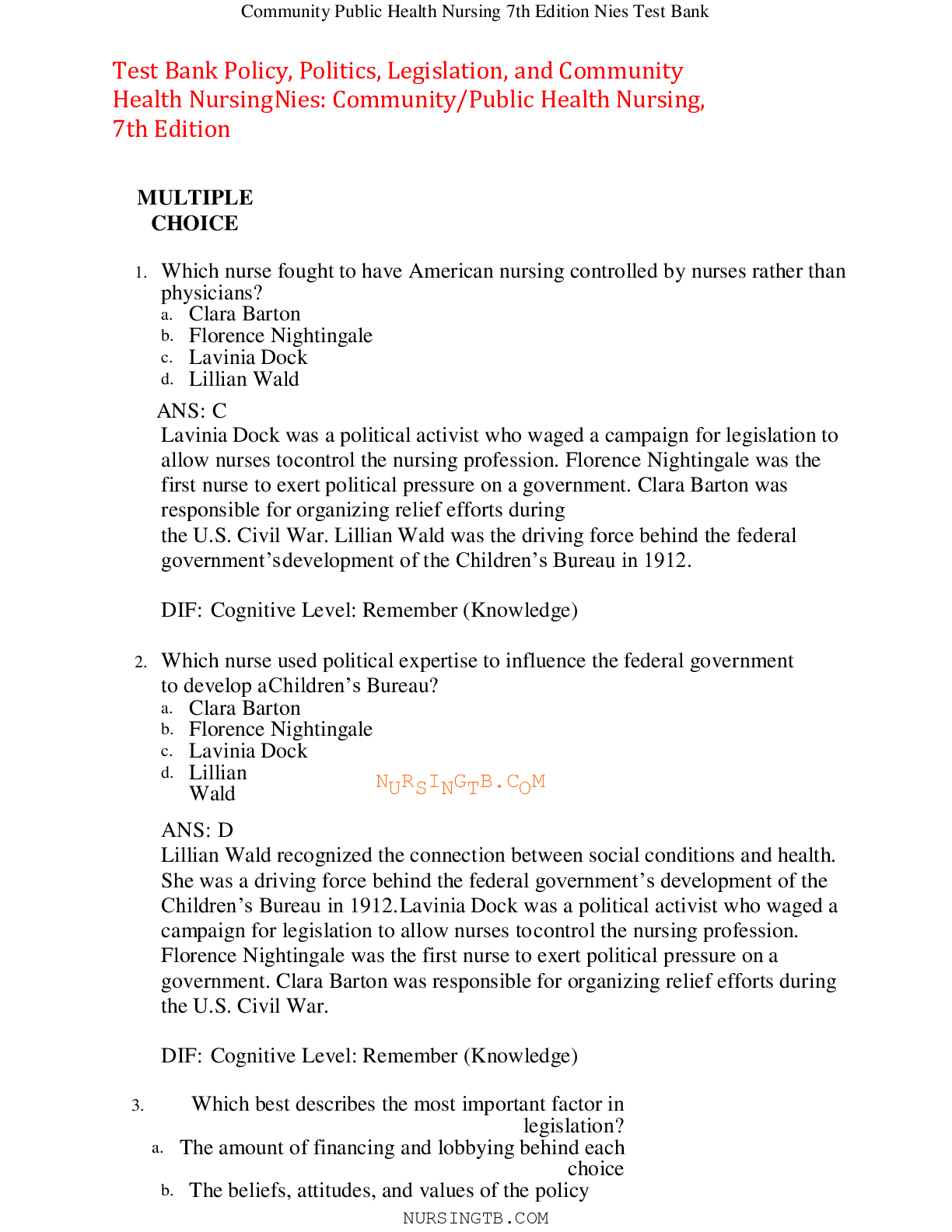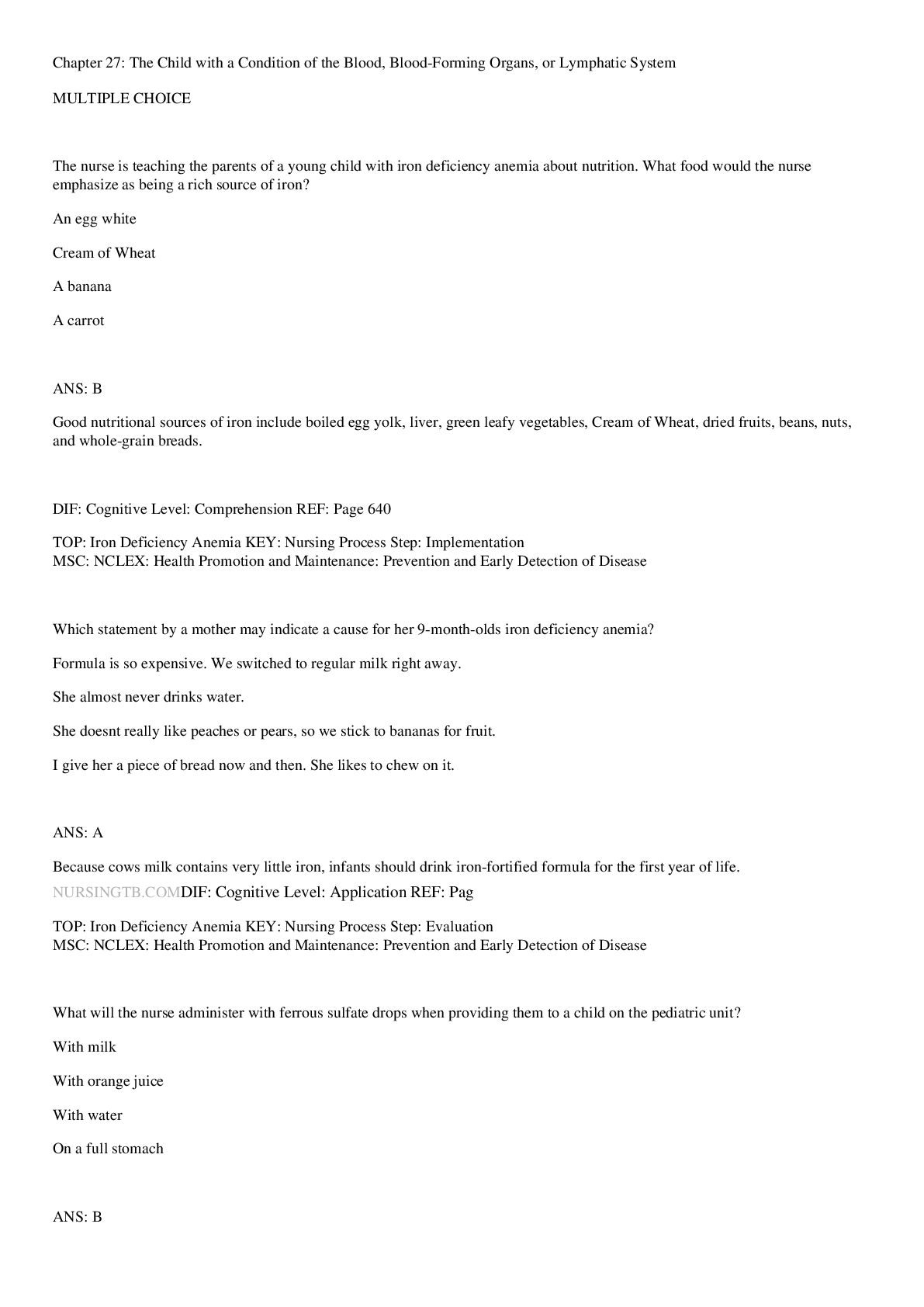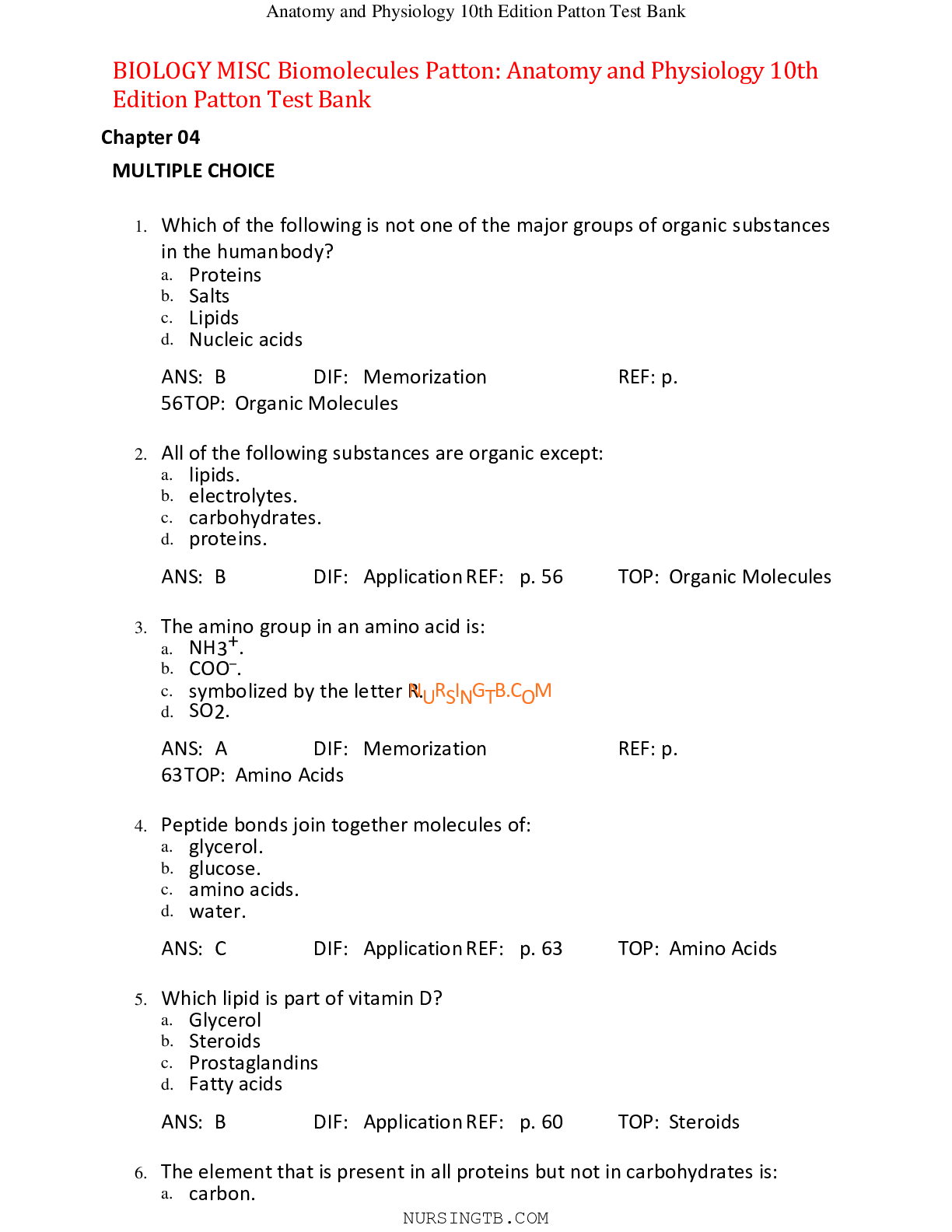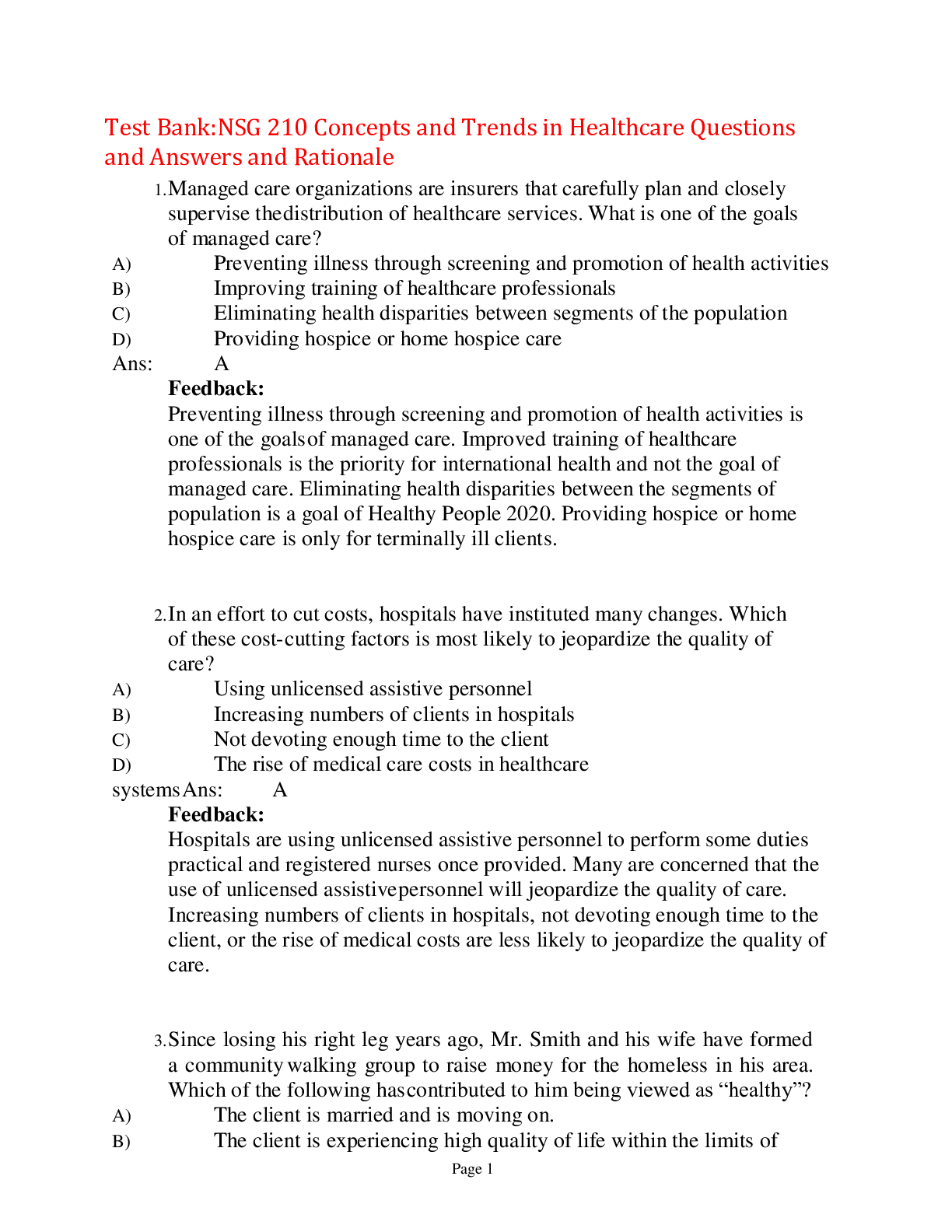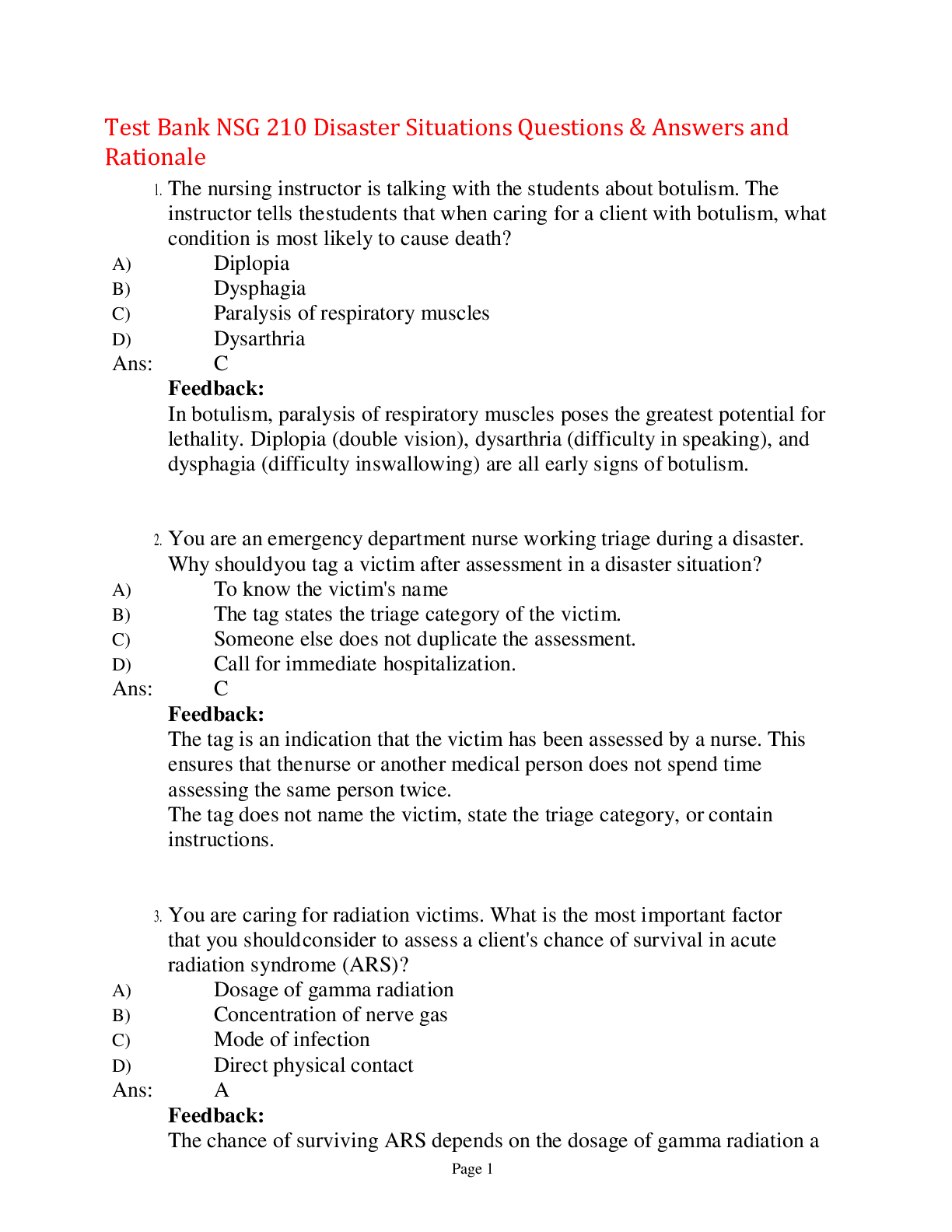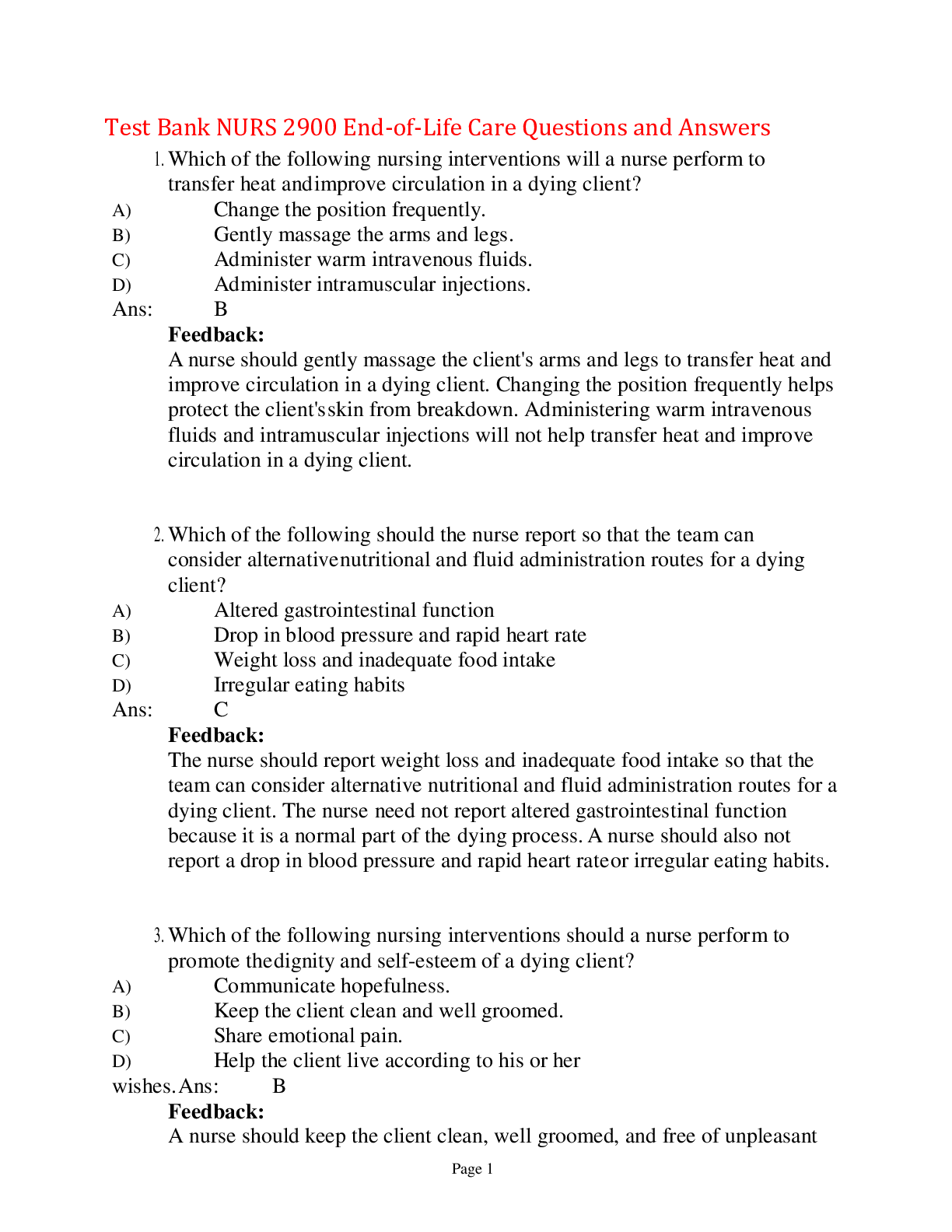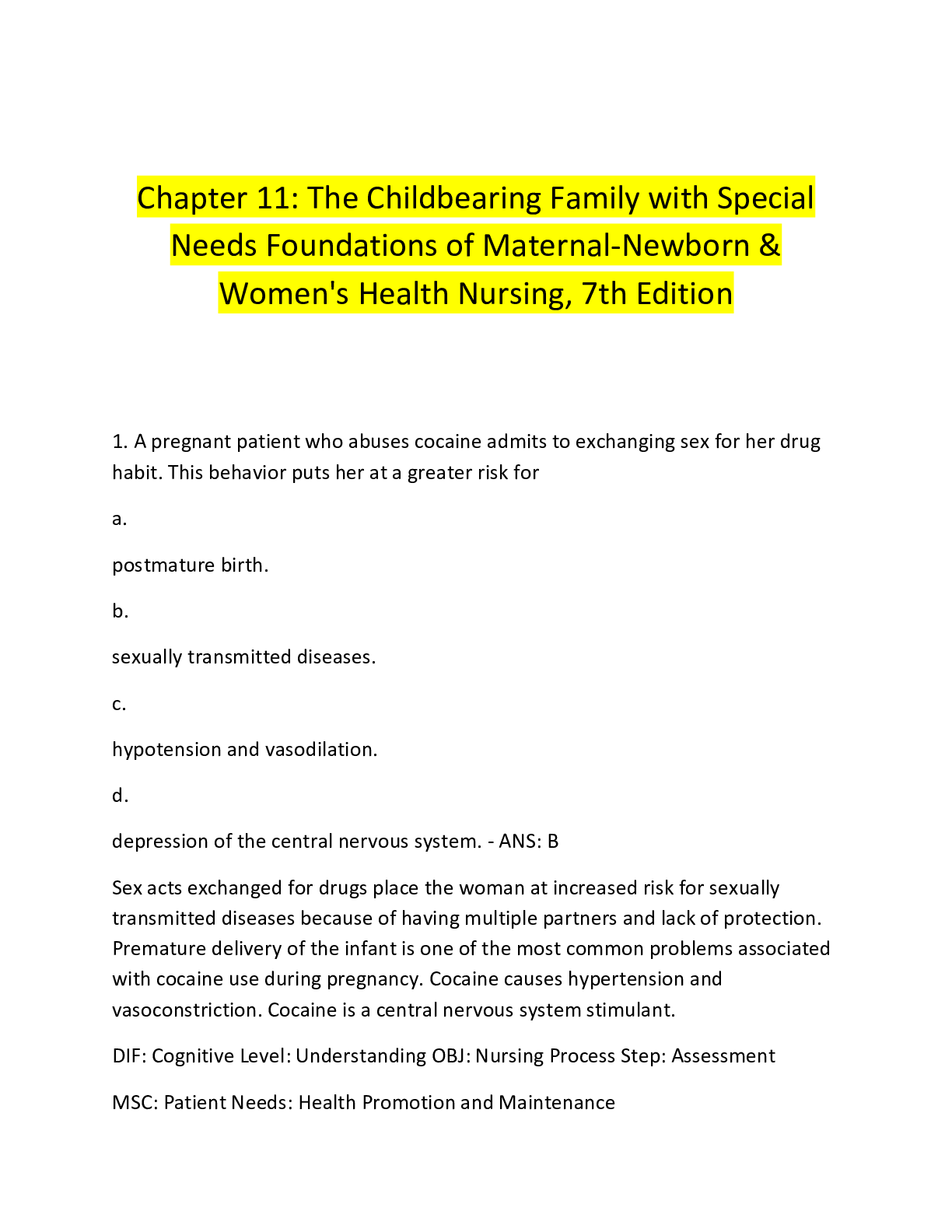*NURSING > TEST BANK > Test Bank NURS 3320 Perioperative Care Questions and Answers and Rationale,100% CORRECT (All)
Test Bank NURS 3320 Perioperative Care Questions and Answers and Rationale,100% CORRECT
Document Content and Description Below
Test Bank NURS 3320 Perioperative Care Questions and Answers and Rationale 1. You are caring for a client 6 hours postsurgery. You observe that the client voids urine frequently and in small amounts.... You know that this most probably indicates what? A) Requirement of intermittent catheterization B) Calculus formation C) Urine retention D) Urinary infection Ans: C Feedback: Voiding frequent, small amounts of urine indicates retention of urine with elimination of overflow. The nurse should assess the volume of first voided urine to determine adequacy of output. If the client fails to void within 8 hours of surgery, the nurse should consult with the physician regarding instituting intermittent catheterization until voluntary voiding returns and is not required in this case. Frequent and small amounts of urine voiding does not indicate urinary infection nor does it indicate the formation of a calculus. 2. You are caring for a client during the immediate postoperative period. What signs and symptoms indicate that the client may be in shock? A) Weak and rapid pulse rate B) Warm, dry skin C) Pooling of secretions in the lungs D) Obstructed airway Ans: A Feedback: Signs and symptoms of shock include pallor, fall in blood pressure, weak and rapid pulse rate, restlessness, and cool, moist skin. Pooling of secretions in the lungs and an obstructed airway predispose the client to hypoxia and not to shock. 3. You are caring for a client postoperatively. What nursing interventions help prevent venous stasis and other circulatory complications in a client who has undergone surgery? A) Place pillows under the client's knees or calves. B) Encourage the client to move legs frequently and do leg exercises. C) Apply pressure on the client's lower extremities. D) Maintain the client in a side-lying position. Ans: B Feedback: The nurse should encourage the client to move legs frequently and do leg exercises to prevent venous stasis and other circulatory complications. The nurse should not place pillows under the client's knees or calves unless ordered and should avoid placing pressure on the client's lower extremities. Placing the client in a side-lying position will not help prevent venous stasis and other circulatory complications in a client who has undergone surgery. 4. The nursing instructor is talking with her class about spinal anesthesia. What would be the nursing care intervention required when caring for a client recovering from spinal anesthesia? A) Turn the client from side to side at least every 2 hours. B) Assist the client to a sitting position at the side of the bed. C) Instruct the client to stay in bed until sensation and movement returns. D) Monitor respiratory rate and sensation every 2 hours or as per ordered. Ans: C, D Feedback: The client who has received spinal anesthesia should remain in bed until sensation and movement returns. Also, the respiratory rate and sensation must be monitored every 2 hours. If permitted, the nurse should turn the client from side to side at least every 2 hours. The client who has received spinal anesthesia should be permitted to sit. 5. Your client required reversal drugs after surgery. What nursing intervention is required when caring for a client who is treated with reversal drugs? A) Instruct the client to lie flat. B) Observe the client for an extended period. C) Help the client slowly move to an upright or standing position. D) Emphasize the dietary restriction. Ans: B Feedback: If reversal drugs are required, the nurse must observe the client for an extended period because the reversal effects nearly always are shorter than the effects of the drugs being reversed. This may result in sedation. The client need not lie flat and may not require assistance for ambulation. There is no specific dietary restriction required when treated with reversal drugs. 6. Several of the clients at the clinic are preparing to have surgery within the next 2 weeks. They are completing preoperative paperwork today with their visit. What are some of the reasons that people might need to have surgery? Select all that apply. A) Cosmetic B) Diagnostic C) Palliative D) Normative E) Causative Ans: A, B, C Feedback: Reasons people have surgery include cosmetic reasons, diagnostic procedures, palliative surgeries, exploratory surgeries, and curative surgeries. Options D and E are distractors. 7. You are a PACU nurse caring for an older adult client who is recovering from surgery. The client tells you he is in pain. You know older adults react to medications differently than younger clients. What does this client's age put them at increased risk for? Select all that apply. A) Acute agitation B) Overdose of pain medication C) Anxiety D) Longer recovery time E) Greater requirement for pain medication Ans: A, B, C, D Feedback: The mechanisms of medication clearance in older adults may be prolonged, leading to risk of overdose. Therefore, older adults usually receive smaller doses of preoperative, intraoperative, and postoperative medications, especially those that affect the central nervous, cardiovascular, and renal systems. The older adult client's reaction to medication puts them at risk for agitation, anxiety, and a longer recovery time. 8. A physically fit 86-year-old is scheduled for right knee replacement. What factor in this client makes him at increased risk for surgery? A) Age B) Type of surgery C) Ability to metabolize medication D) Nutritional status Ans: A Feedback: On admission, the nurse reviews preoperative instructions, such as diet restrictions and skin preparations, to ensure the client has followed them. If the client has not carried out a specific portion of the instructions, such as withholding foods and fluids, the nurse immediately notifies the surgeon. He or she identifies the client's needs to determine if the client is at risk for complications during or after the surgery. General risk factors are related to age; nutritional status; use of alcohol, tobacco, and other substances; and physical condition. In this scenario, the risk to the client is age; the other options are incorrect according to the scenario described. 9. The nurse is completing an assessment of the patient prior to surgery. What areas of the patient assessment should the nurse question further? Select all that apply. A) Medication B) Elimination C) Activity D) Support system E) Religious preference Ans: A, B, C, D Feedback: When preparing a client for surgery, these areas need to be addressed: skin preparation, elimination, attire/grooming, prosthesis, foods and fluids, and care of valuables. In addition, medication, activity, and the client's support system must be assessed. 10. You are working in the preoperative area with a client going to surgery for a cholecystectomy. The client has histamine2-receptor antagonists ordered preoperatively. The client asks you why these medications are needed. What would be your best answer? A) “These medications slow motor activity.” B) “These medications decrease the amount of anesthesia you will need.” C) “These medications decrease anxiety before surgery.” D) “These medications decrease gastric acidity and volume.” Ans: D Feedback: The anesthesiologist frequently orders preoperative medications. Common preoperative medications include the following: anticholinergics, which decrease respiratory tract secretions, dry mucous membranes, and interrupt vagal stimulation; antianxiety drugs, which reduce preoperative anxiety, slow motor activity, and promote induction of anesthesia; histamine2-receptor antagonists, which decrease gastric acidity and volume; narcotics, which decrease the amount of anesthesia needed, help reduce anxiety and pain, and promote sleep; sedatives, which promote sleep, decrease anxiety, and reduce the amount of anesthesia needed; and tranquilizers, which reduce nausea, prevent emesis, and enhance preoperative sedation. 11. The nurse has provided preoperative instructions to a client scheduled for surgery at an ambulatory care center. Which statement, made by the client, would indicate that further instruction is needed? A) “If I do not follow the instructions, my surgery could be cancelled.” B) “The nurse will explain the details of the surgery before I sign a consent.” C) “My medical records will be sent to the ambulatory care center prior to my surgery.” D) “The physician will update my family after the procedure and provide specific discharge instructions.” Ans: B Feedback: Further instruction would be needed to clarify that the physician, not the nurse, explains the details of the surgery and obtains voluntary consent for the procedure. It is correct that preoperative instructions must be followed prior to surgery for the safety of the client, medical records are present for review prior to surgery, and the physician speaks with the family following the procedure and provides instructions for discharge. 12. The nurse is reviewing a preoperative informed consent when preparing the client for surgery. Which contents of the informed consent are required? Select all that apply. A) Explanation of procedure B) Estimated time of procedure C) Potential risks D) Benefits of surgery E) Personnel present F) Description of alternatives Ans: A, C, D, F Feedback: Informed consents should be in writing and contain an explanation of procedure and risks, description of benefits and alternative, an offer to answer questions about procedure, ability to withdraw consent, and statement informing the client if the protocol differs from customary procedure. An estimated time of procedure and personnel present are not required in the informed consent. 13. When assessing a postoperative client, the nurse is correct to relate which surgical risk factor that would decrease if the surgical client maintained a blood glucose level under 150 mg/dL? A) Nutrient deficiencies B) Respiratory complications C) Wound healing D) Liver dysfunction Ans: C Feedback: In caring for a postoperative client, the nurse is correct to correlate hyperglycemia with an increased risk of surgical incision infections and delayed wound healing. There is no direct correlation between blood glucose levels and nutrient deficiencies, respiratory complications, and liver dysfunction. 14. The nurse has received shift report on a postoperative surgical client. Which medication order would indicate that the medication was being administered prophylactically? A) A 5% dextrose in 0.5 NSS to infuse at 100 mL/hr B) Percocet two tablets every 4 hours as needed for pain C) Humulin NPH 12 units at 0800. D) Amoxicillin 500 mg two tablets every 8 hours for 48 hours Ans: D Feedback: A prophylactic antibiotic is administered either before surgery, after surgery, or both before and after surgery to prevent postoperative infections. Intravenous solutions are typically administered for hydration and allow for medication administration. Pain medications such as a Percocet decrease surgical pain. Humulin NPH insulin reduces blood glucose levels. 15. When assessing the client postoperatively, which nursing consideration is essential before offering oral fluids? A) Assess ability to swallow. B) Assess urinary output. C) Assess pain level. D) Assess positioning. Ans: A Feedback: Before giving oral fluids, it is essential that the client has recovered sufficiently to be able to swallow. Assessing urinary output, pain level, and positioning is completed postoperatively but does not impact the ability to offer oral fluids. 16. The nurse is caring for a client being transitioned from the postanesthesia care unit (PACU) to the surgical nursing floor. Which nursing action is first when a client states, “I am nauseated”? A) Obtain an emesis basin and cool washcloth. B) Check the medication record for antiemetic medication orders. C) Obtain vital signs. D) Encourage sips of clear liquids. Ans: A Feedback: Nausea is a frequent symptom in the postoperative period. When a client states being nauseated, the nurse's first action is to provide an emesis basin in case the client vomits. Once the client is provided for, next the nurse would check the MAR to provide a prescribed antiemetic. Vital signs would be obtained per postoperative protocol, and liquids would be held until the nausea subsides. 17. The nurse is reviewing a postoperative client's chart prior to a physician's office visit. Lab reports reveal a prior WBC of 40,000/mm3, a current WBC count of 8000/mm3, and a current wound culture negative, following a Staphylococcus aureus infection. Tertiary intention of wound healing is documented at the last visit. Which current assessment of wound healing is anticipated? A) Wound edges well approximated. No redness/swelling noted. B) Edges of incision well approximated with the center of incision open. Green purulent drainage noted. C) Wound edges sutured. Scant amount of drainage noted. No foul odor. D) Wound packed with 12 inch sterile packing material; interior pink. Ans: C Feedback: The scenario stated a previous wound infection that has resolved. Sutured wound edges are present once the wound has been cleaned of infection as noted in tertiary intention of wound healing. Well-approximated edges are healing without infection. Wound packing is noted in secondary intention. Green purulent drainage is noted with a wound infection. 18. The nurse is providing community instruction on the impact of aging and surgical incisional considerations. Which instructional areas would be included in the presentation? Select all that apply. A) Increase protein in the diet. B) Instruct on symptoms of wound/incision infection. C) Cleanse wound/incision with products such as soap and water. D) Avoid showering until healing has occurred. E) Wash with half-strength peroxide to prevent infection. F) Remove any crusted areas from incisional line. Ans: A, B, C Feedback: The nurse realizes that there is a thinning of the skin and loss of subcutaneous tissue, which is normal in the aging process. Also, older adults may have a diminished immunological response, making them more susceptible to infection. For this reason, instructional areas would include areas which promote healing and diminish the risk of infection. Increasing protein in the diet promotes wound healing. Instructing on signs and symptoms of wound infection allows for early symptom recognition. Cleansing, as per physician instruction, but with products, such as soap and water, decreases bacteria on the skin. Showering may begin prior to healing with the stream of the water not directly on the incision. Peroxide is not recommended for wound/incisional care. Crusted areas should be allowed to heal and flake off. Removing the areas could open a wound allowing for bacteria to enter. 19. The nurse is caring for the client in the preoperative period and documenting rationale for a palliative surgical procedure. Which rationale is most appropriate? A) The physician needs additional information to plan medical treatment. B) The client wishes to improve body structures and elects a procedure. C) The physician is repairing a deformity from birth or disease process. D) The client and physician are focusing on symptom relief not a cure. Ans: D Feedback: The nurse realizes a palliative surgical procedure is focused on the relief of symptoms or enhancement of function without a cure. Diagnostic surgical procedures provide additional information for medical diagnosis and treatment. Cosmetic surgery procedures are elective, with the purpose of improving body appearance. Reconstructive surgery corrects a deformity. 20. The nurse is assigned a client scheduled for an outpatient colonoscopy in an ambulatory care setting. During which phase of perioperative care would the nurse document the admission vital signs in the recovery room? A) During the preoperative phase B) During the intraoperative phase C) During the transfer phase D) During the postoperative phase Ans: D Feedback: The nurse realizes that documentation of vital signs in the recovery room begins the postoperative phase of perioperative care. The preoperative phase occurs until the client reaches the operating area. The intraoperative phase includes the entire surgical procedure until the transfer to the recovery area. There is no transfer phase of perioperative care. 21. At which time does the nurse realize that it is best to begin teaching about care needed during the postoperative period? A) During the preoperative period B) Upon arrival to the surgical unit C) Following the surgical procedure D) At the time of discharge instructions Ans: A Feedback: The best time to begin teaching about care needed in the postoperative period is during the preoperative time. At this time, the client is more alert and focused on the information provided by the nurse. Clients and family members can better be prepared and participate in the recovery period if they know what to expect. Anxiety is a factor on arrival to the surgical unit that could interfere with learning. Pain could interfere with the learning process, following a surgical procedure. At the time of discharge, both pain and timeliness may be an issue in understanding and obtaining care needed during the postoperative time. 22. The nurse is caring for a client needing emergency surgery. Which preoperative teaching should be omitted to prepare the client for surgery? A) Effective coughing and deep breathing B) Types of postoperative pain medication C) Frequency of postoperative vital signs D) Knowledge of surgical procedure Ans: C Feedback: The least helpful postoperative teaching that could be omitted due to the need to obtain emergency surgery is explaining the frequency of postoperative vital signs. This is not essential information to improve client participation in their postoperative recovery. Coughing and deep breathing is essential in the immediate postoperative period. Clients are often concerned about postoperative pain so instruction on pain medication can decrease anxiety. Knowledge of the surgical procedure must be explained by a physician when signing a surgical consent. 23. Which nursing statement would best decrease a client's anxiety before an emergency operative procedure? A) “You will be just fine; the operating room nurses will take good care of you.” B) “It is best to take deep breaths and relax before the procedure.” C) “Let me explain to you what will happen next.” D) “We will keep your family informed of your progress.” Ans: C Feedback: Many clients feel fearful of knowing little about the operative procedure and what to expect. This fear causes anxiety and can lead to a poorer response to surgery and surgical complications. Explanations of what the client is to expect can help to decrease anxiety. False reassurance of being fine does not diminish anxiety. Deep breathing and relaxation techniques can be helpful to the client, but addressing the source of the anxiety is more beneficial. Keeping the family informed helps the family and is not client focused. 24. The nurse is admitting and preparing the client for surgery. Following administration of Ativan 2 mg orally, one time dose, which safety measure is most appropriate? A) Place the client in a semi-Fowler's position. B) Place the side rails in the up position. C) Remove the water pitcher from the bedside. D) Instruct the family to call for any client needs. Ans: B Feedback: Ativan is a common hypnotic administered to reduce preoperative anxiety. The most appropriate safety measure is to limit the client's ability to get out of bed following administration of a preoperative sedative. Assistance is needed to maintain client safety. Placing the client in a semi-Fowler's position aids in gas exchange, but this is not indicated as a concern in this question and does not relate to a safety concern associated with this medication. Water should not be at the bedside for a client in the preoperative phase. Families can be helpful support for the client; however, it is the nurse's responsibility to maintain safety. 25. The surgical unit nurse is developing a postoperative plan of care. In which client's plan of care would the nurse document interventions of coughing and deep breathing, gastrointestinal assessment, and effective regulation of temperature? A) A client with gastrointestinal surgery and general anesthesia B) A client having a knee replacement and regional anesthesia C) A client having lower extremity muscle repair and spinal anesthesia D) A client with spinal stenosis and a regional nerve blockade Ans: A Feedback: General anesthesia acts on the central nervous system to produce a loss of sensation, reflexes, and consciousness. The anesthesiologist monitors the vital functions of breathing, circulation, and temperature. Following general anesthesia, nurses must closely monitor for effective breathing and oxygenation, temperature regulation, and adequate fluid balance. Nursing interventions for those clients with regional anesthesia, spinal anesthesia, and regional nerve blockades focus on assessing for allergic reactions, neurovascular assessments to specific body regions, and side effects of the medication. 26. The nurse is caring for a client during an intraoperative procedure. When assessing vital signs, which result indicates a need to alert the anesthesiologist immediately? A) Pulse rate of 110 beats/min B) Respiratory rate of 18 breaths/min C) Blood pressure of 104/62 mm Hg D) Temperature of 102.5° F Ans: D Feedback: Intraoperative hyperthermia can indicate a life-threatening condition called malignant hyperthermia. The circulating nurse closely monitors the client for signs of hyperthermia. The pulse rate, respiratory rate, and blood pressure did not indicate a significant concern. 27. An enterostomal therapy nurse is caring for a postoperative client with a gaping wound. Which nursing measure is most helpful when a wound dressing adheres to the wound bed? A) Place a transparent dressing between the wound and dressing. B) Place an emollient based ointment on the wound bed. C) Use normal saline to soak the dressing for removal. D) Allow the dressing to dry and release the wound bed. Ans: C Feedback: When a dressing adheres to the wound bed, using normal saline to moisten the dressing material can loosen the dressing for easier dressing removal without damaging the new tissue or causing discomfort. The transparent dressing and ointment are not helpful in assisting with dressing removal. Allowing the dressing to dry promotes wound adherence. 28. A client is placed on the operating room table for the surgical procedure. Which surgical team member is responsible for handing sterile instruments to the surgeon and assistants? A) Scrub nurse B) Circulating nurse C) First assistant D) Certified registered nurse anesthetist Ans: A Feedback: The scrub nurse is sterile and assists the surgical team by handing instruments to the surgeon, preparing sutures, receiving specimens to be sent to the lab, and counting sponges and needles. The circulating nurse is not sterile and obtains and opens sterile equipment, adjusts lights, and keeps records. The first assistant is involved with the client's preoperative care. The certified registered nurse anesthetist assists in the client's anesthesia. 29. A postoperative client is moving from the bed to a chair when blood drips from the dressing. The nurse assesses the incision and notes evisceration. What does the nurse do first? A) Place a dry, sterile dressing over the protruding organs. B) Place a pressure dressing over the opening and secure. C) Have the client lay quietly on back and call the physician. D) Moisten sterile gauze with normal saline and place on any organ. Ans: D Feedback: A wound evisceration occurs when the wound completely separates, and the internal organs protrude. The first action by the nurse would be to cover the protruding organs with sterile dressings moistened with normal saline. Once the client is safe, the nurse can notify the physician. The client is positioned in a manner that places the least stress on the organs. Dry or pressure dressings are placed over the protruding organ. 30. The nurse is planning care for a client following abdominal surgery. Which outcome demonstrates a return of functioning to the gastrointestinal tract? A) The client is tolerating sips of water. B) The client reports a small bowel movement. C) The client is passing flatus. D) The client states being hungry. Ans: B Feedback: A bowel movement demonstrates that the nursing outcome of the return to function of the gastrointestinal track has been met. All of the other options are components of meeting the outcome of functioning. 31. The nurse is caring for a female postoperative client who is having difficulty voiding. Which nursing action is most helpful to promote normal voiding? A) Run water to assist in the let-down reflex. B) Encourage 8 oz of water. C) Assist to the bathroom. D) Offer to catheterize. Ans: C Feedback: The nurse encourages the client to void within 4 hours of surgery to minimize the risk of a urinary tract infection. Ambulating the client to the bathroom promotes normal body positioning for urination. Running water is a common psychological strategy to cause urination, but positioning is a better option. Encouraging water will help fill the bladder but not urination. Offering to catheterize is a last option. 32. The nurse is assessing the postoperative client on the second postoperative day. Which assessment finding requires immediate physician notification? A) The client has an absence of bowel sounds. B) The client's lungs reveal rales in the bases. C) The client states a moderate amount of pain at the incisional site. D) A moderate amount of serous drainage is noted on the operative dressing. Ans: A Feedback: A nursing assessment finding of concern on the second postoperative day is the absence of bowel sounds, which may indicate a paralytic ileus. Other assessment findings may include abdominal pain and distention as fluids, solids, and gas do not move through the intestinal tract. Rales in the bases are a frequent finding postoperatively, especially if general anesthesia was administered. Encourage the client to cough and deep breathe. Pain is a common symptom following a surgical procedure. Serous drainage on the postoperative dressing needs to monitored and brought to the physician's attention when he or she assesses the client. 33. Which teaching point would the nurse stress to decrease the risk of a phlebitis? A) Massage the calves and thigh. B) Prop pillows under knees. C) Encourage ambulation twice daily. D) Avoid crossing the legs. Ans: D Feedback: Phlebitis is the swelling and inflammation of a vein and is a symptom associated with thrombophlebitis. To decrease the risk of phlebitis instruct on ways to promote blood circulation and limiting trauma to the site. Avoiding leg crossing promotes circulation. Massaging the calves and thighs may cause further swelling and inflammation of the vein. Propping pillows under the knees decreases circulation. Ambulation is stressed each hour while awake. 34. When planning care for a client in the postoperative period, prioritize nursing diagnoses in the sequence from highest to lowest priority? A) Impaired Gas Exchange B) Risk for Infection C) Altered Comfort D) Fluid Volume Deficit E) Anxiety Ans: A, B, C, D, E Feedback: According to the Maslow's hierarchy of deeds, airway and gas exchange is of the highest priority. Next would be the deficiency in fluid volume. Altered comfort would be higher than anxiety because decreasing pain may alleviate/reduce anxiety. Lastly, a risk for diagnosis is not a current problem but an important teaching point to reduce the risk. [Show More]
Last updated: 1 year ago
Preview 1 out of 25 pages
Instant download
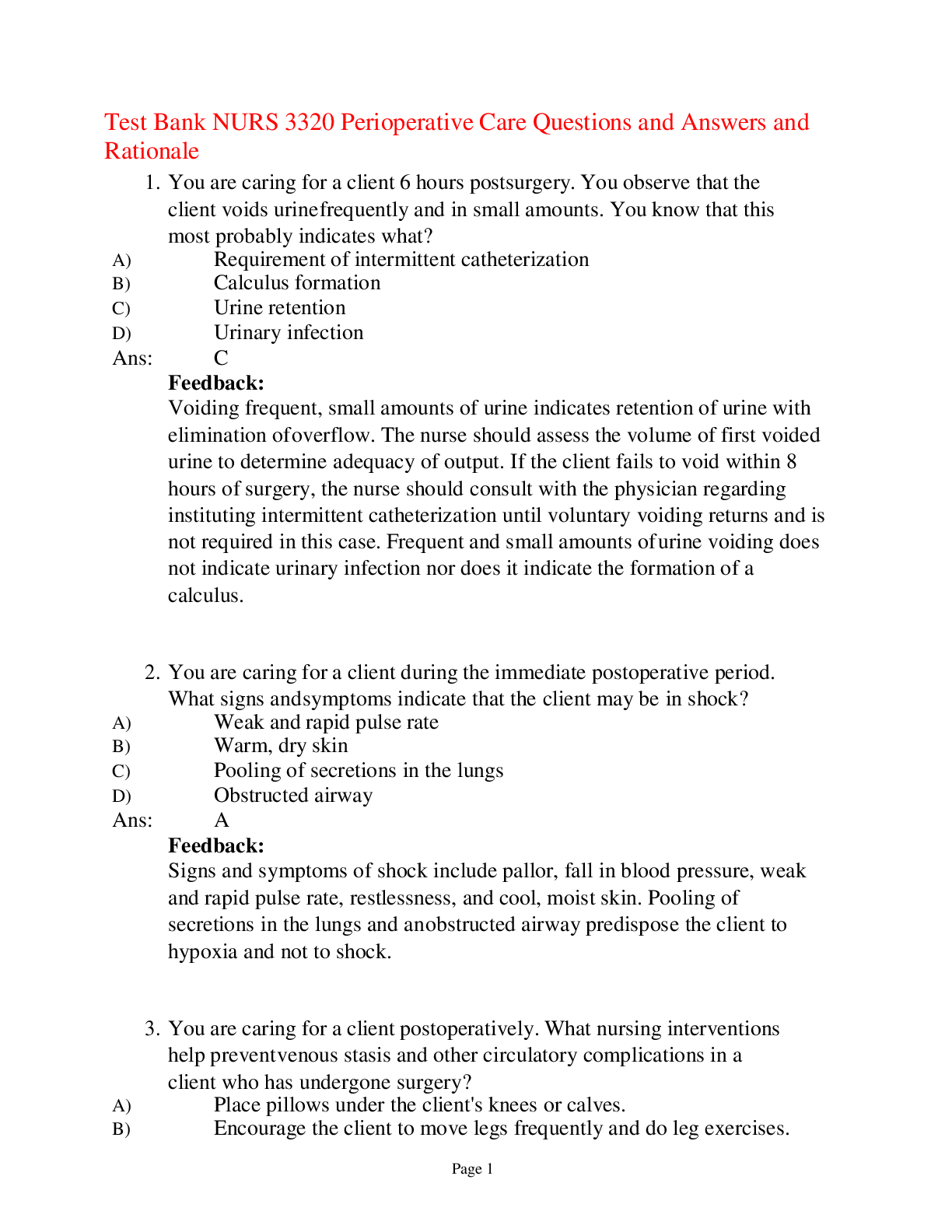
Buy this document to get the full access instantly
Instant Download Access after purchase
Add to cartInstant download
Reviews( 0 )
Document information
Connected school, study & course
About the document
Uploaded On
Sep 22, 2022
Number of pages
25
Written in
Additional information
This document has been written for:
Uploaded
Sep 22, 2022
Downloads
0
Views
64

